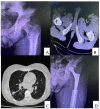Management of Lung Cancer Presenting with Solitary Bone Metastasis
- PMID: 36295624
- PMCID: PMC9612355
- DOI: 10.3390/medicina58101463
Management of Lung Cancer Presenting with Solitary Bone Metastasis
Abstract
Lung neoplasm is the main cause of cancer-related mortality, and bone metastasis is among the most common secondary tumors. The vast majority of patients also present with multiple bone metastases, which makes systemic and adjuvant pain therapy preferable to surgery. The optimal approach for a resectable non-small-cell lung tumor that also presents a unique, resectable bone metastasis is not fully established. The number of papers addressing this subject is small, and most are case reports; nevertheless, survival rates seem to increase with radical surgery. The sequencing of local versus systemic treatment should always be discussed within the multidisciplinary team that will choose the best approach for each patient. As targeted systemic therapies become more accessible, radical surgery, together with existing reconstructive methods, will lead to an increase in life expectancy and a better quality of life.
Keywords: bone metastasis resection reconstruction; lung cancer; radical therapy; solitary bone metastasis; targeted therapy.
Conflict of interest statement
The authors declare no conflict of interest.
Figures



References
-
- Kagohashi K., Satoh H., Ishikawa H., Ohtsuka M., Sekizawa K. Bone metastasis as the first manifestation of lung cancer. Int. J. Clin. Pr. 2003;57:184–186. - PubMed
Publication types
MeSH terms
LinkOut - more resources
Full Text Sources
Medical
Research Materials

